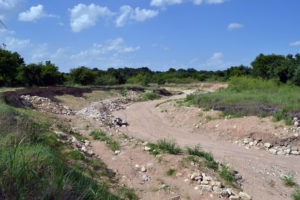Creek project creates long delay for bridge replacement in Southeast Austin
Thursday, June 15, 2017 by
Caleb Pritchard A major piece of cycling and pedestrian infrastructure in Southeast Austin will have been out of commission for nearly five years before it finally reopens, according to the most optimistic plans at the city of Austin’s Watershed Protection Department.
The bridge over what’s known as Country Club Creek West in Roy G. Guerrero Colorado River Park washed out after a series of floods in 2015. According to Watershed Protection Department spokesperson Lynne Lightsey, construction on a replacement bridge, which could begin in late 2018 or early 2019, won’t be completed until early 2020. However, Lightsey cautioned, “Please keep in mind that weather, especially lots of rain and flooding, could delay the project.”
The bridge was originally built in 2010 and is a critical piece along a trail that connects the Ann and Roy Butler Hike-and-Bike Trail to the baseball fields and disc golf course in the eastern half of the park, the Austin Community College Riverside Campus and the Montopolis neighborhood.
Signs posted near the washed out bridge direct trail users to use a sweeping detour south on South Pleasant Valley Road, east of East Riverside Drive, and then north on Grove Boulevard, a three-mile bypass along busy arterials to access the ACC campus from the bridge’s location. If it were still there, the journey would only be about 1.3 miles.
According to former Urban Transportation Commissioner Allen Demling, the detour is “clearly not a solution that was recognized by anybody who has cycled in that area because it’s far more dangerous.”
He also vented frustration at the extended timeline to fill in a glaring gap in the city’s urban trail network. “If it was a bridge for cars, there’s no question they would fix it as soon as they can,” Demling said.
While local jurisdictions did indeed race to replace automobile bridges lost to recent floods, city staff explained to the Austin Monitor that this particular case involves a much larger engineering effort that will fix a decades-old problem caused by irresponsible meddling with Mother Nature herself.
“There’s a long history of creeks being rerouted for convenience and this is just one of those stories,” Janna Renfro of the Watershed Protection Department explained.
According to Renfro, Country Club Creek West was created in 1976 as a bypass channel designed to remove a large section of the area along the original Country Club Creek from the floodplain in order to allow for apartment construction. The channel was designed to provide a straighter, quicker route for creek water to reach the Colorado River. However, for some uncertain reason, the channel never provided “adequate conveyance” to the river, Renfro said.
“Over time, the creek just had to find its own path to the river,” she said. And with a straighter path through sandy soil, the creek is carving that path through a particularly powerful method of erosion. Or as Renfro put it, “It’s kind of like having a hose in a sandbox.”

The effects of that erosion are palpable. Shortly after the bridge initially failed, the creek bed was a shallow, narrow affair. Today, it is a vast gully some 20 feet deep.
Under those alarming conditions, simply reinstalling the bridge would be an imprudent solution. Renfro explained that the bridge replacement is only one piece of a broader initiative to stabilize the entire creek itself. That project is expected to cost $13 million.
So far the department has identified $5.5 million for the project, while the Parks and Recreation Department has indicated it can contribute $2.5 million. Renfro said the city is pursuing grants from the Federal Emergency Management Agency that could possibly exceed the remaining $5 million gap.
Nonetheless, work on the project is moving forward, Renfro said. Along with the consulting firm HDR, Renfro’s team wrapped up preliminary engineering last year and is moving into the design phase this month.
As Lightsey pointed out, if the weather cooperates, the project should wrap up in early 2020. In the meantime, the scale of the work will preclude any possibility of a temporary span to connect the bisected trail.
“We understand that it is a big inconvenience to commuters and park users, and it’s something that makes us really uncomfortable too,” Renfro said. “But there’s not much we can do to provide a stable, safe crossing. When construction starts, the whole thing will be closed off.”
The Austin Monitor’s work is made possible by donations from the community. Though our reporting covers donors from time to time, we are careful to keep business and editorial efforts separate while maintaining transparency. A complete list of donors is available here, and our code of ethics is explained here.
You're a community leader
And we’re honored you look to us for serious, in-depth news. You know a strong community needs local and dedicated watchdog reporting. We’re here for you and that won’t change. Now will you take the powerful next step and support our nonprofit news organization?



